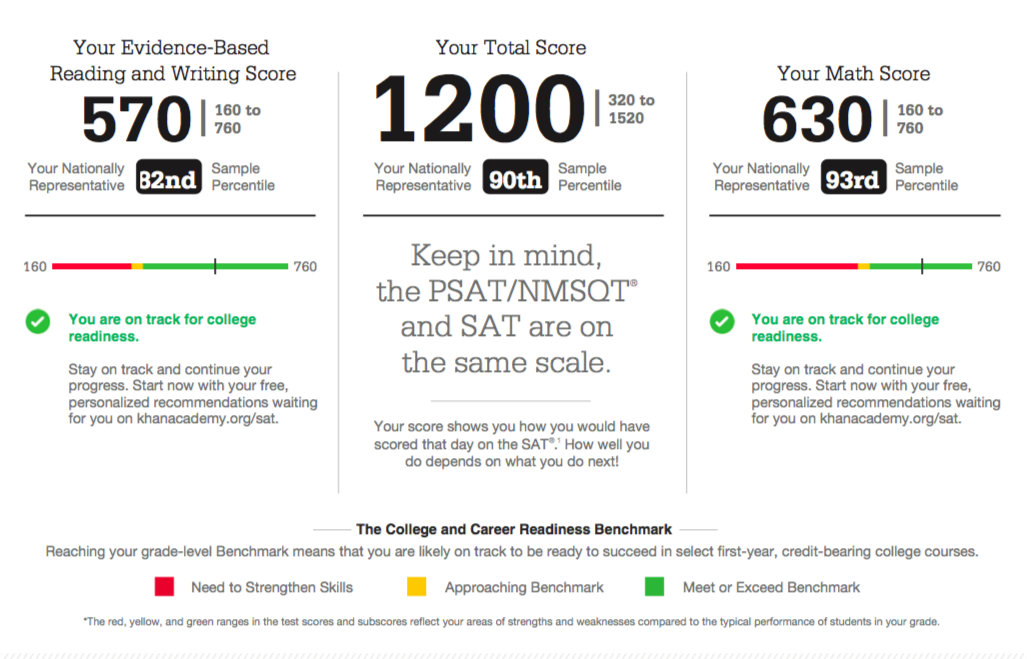If you’ve recently received a PSAT score report for your 10th or 11th grade student, you might be wondering what all these numbers mean.
More importantly, what should you do with the PSAT report to help your student improve?
Great questions! This short article will walk you through a sample score report and tell you what parts of the report are worth your attention and which are not. I will also give you some steps you can take to help your student move forward in the test preparation process.
Download the PSAT score report and let’s jump in!
“Your Total Score”
One of the first questions I often get asked is, “Is this a ‘good’ score or a ‘bad’ score?”
In my opinion, ‘good’ or a ‘bad’ scores are not the most helpful way to look at your performance. What is important is how your student compares to everyone who took the test. Getting into college is a competition - a competition against the other people who also want to get into that college. Colleges must compare and decide who will get in and who will not.
Luckily, there are lots of colleges with lots of openings. This is great news because your students doesn’t have to compete with EVERYONE, just the people that want to get into the schools to which they are applying.
If you look at the score summary above, you can see that there are 3 main numbers: a Language score (Reading and Writing), a Math score and a Total.
The scores on the PSAT are out of a maximum section score of 760, while the maximum score on the SAT is 800. The PSAT is max is lower because it attempts to predict how your student would do on the regular SAT if they took it with no further preparation.
A more helpful number on the Total Score page are the percentiles. A percentile is simply a number that tells you how you compared to everyone else who took the test. In this case, the 82nd percentile means that 82% of people scored worse than this person on the Language sections. That’s good - remember, the test is a comparison tool. This student beat 82% of people who took the test. This person also did well on Math, beating 93% of people. Notice that there is a final percentile for the total score, which is just the Language and Math scores added. Here, 90% of people scored worse than this person on the overall test. Excellent!
What if your student’s scores aren’t as high as this person?
It’s ok. This is a practice test.
If your student did their best on the test, it gives you decent snapshot of how prepared they are to take the real test, as well as how they stack up to all the people they’re competing with for college admission.
On the other hand, it’s also only a foundation. Just because your student may not have scored as well as they were hoping this time, does not mean you’re doomed to repeat that score.
I have personally coached hundreds of students to improve their scores...they can improve their score too!
“Subscores”
A new section for the score report is a list of subscores. College Board has broken down the Reading, Writing and Math sections on the left, and on the right has broken those scores even further into subtopic scores for each section.
Read this as a comparison of topics on which the SAT tries to test students. You should look for two things: inconsistency, and patterns. This score report shows excellent consistency. Nearly all of the score lines are in the green area, in a fairly predictable range. For inconsistency, look for subscore areas that are much higher than the average or much lower than the average.
For example, on this report, “Standard English Conventions” is the only subscore in the yellow range. DO NOT read this as an indication that you simply need to study English Conventions to improve your subscore.
There are way too many factors that affect score performance. Maybe they don’t know some grammar rules, but it could also be that they found the style of these questions confusing, or that they misread all of these questions, or that they were overconfident, or any myriad other possibilities.
In short, subscores can help identify a starting point for improvement, but it is rarely as simple as brushing up on a few language rules or math topics.
“Next Steps”
Based on the questions that students get correct as well as incorrect, College Board presents automatically generated responses to affirm the skills your student already has as well as to help guide them toward what they need to do to improve your score for each main subject area.
Mostly these recommendations are pointless. Their suggestions assume that the reason that a student missed a question was simply because of the content, which in turn is based on what they think they are testing when they present their questions.
I can tell you from over 3000 hours of experience tutoring these tests that what the College Board thinks their questions are asking is often vastly different that what students think the questions are asking.
“Your Question-Level Feedback”
If your student wants to improve their score performance, this is the most important section of the report. Questions are listed for each section along with the correct response, your response (if missed), the difficulty level and the subscore areas into which the College Board thinks the question falls.
The best way to use this section is to download the test questions and answers from the College Board website. (There’s an access code for your test questions at the bottom of your score report.) Your student should work through each question and figure out why the right answer is correct as well as why they missed it.
The fastest and most effective way to improve is to thoroughly process your missed questions by determining exactly what you did wrong and explaining in detail what you will do next time to correct your mistake.
A great tutor can help you understand not just the question or the content behind it but also develop techniques unique to you to make sure that you execute similar questions effectively every time.
ACTION STEPS: What should you do next?
Now that you understand the PSAT Score Report, here’s what you should do next:
Step 1: Log in and access the questions and answers to the PSAT from the College Board website.
Step 2: Have your student thoroughly process their missed questions and the correct answers as described above in “Question Level Feedback.” Or schedule a session with me and I will work with your student to help them understand and correct their mistakes. This is true for both Sophomores and Juniors.
Step 3: For Juniors, look ahead at both the SAT and ACT test dates as well as registration dates. Most college college counselors recommend that students take BOTH tests at least once. Think about issues like school breaks, vacations, sports schedules and preparation time. In general it takes 8-10 weeks of weekly work for a beginning student to prepare effectively for their first test.
Step 4: Email me or give me a call. I will answer any of your particular questions as well as help you decide the best way for your student to proceed. Here are some specific ways I can be helpful to you in this process:
- Strategize when to take the Test.
- Schedule 1-2 sessions to work through missed PSAT questions and develop a customized preparation plan.
- Complete 1-on-1 tutoring for SAT/ACT preparation.
Step 5: Know another family who would love to know this information? Forward this article to them!
Ultimately my goal for every student is to help them feel confident taking the SAT and ACT and for their scores to be an accurate reflection of their abilities as a student.
- Kevin




